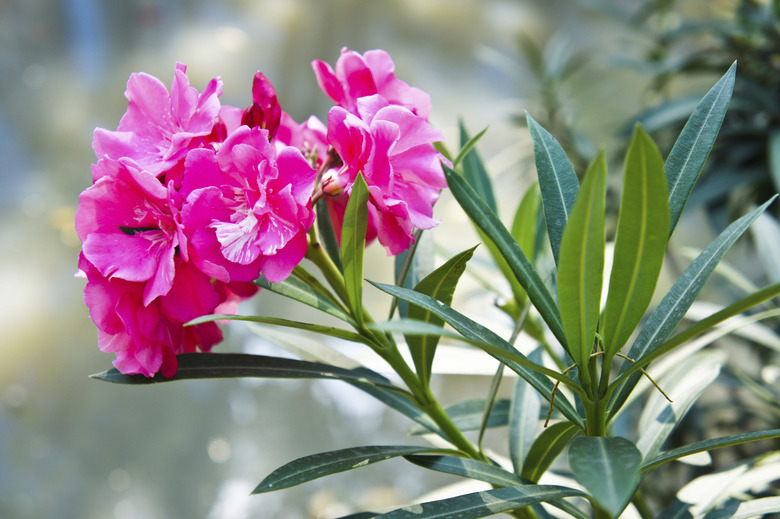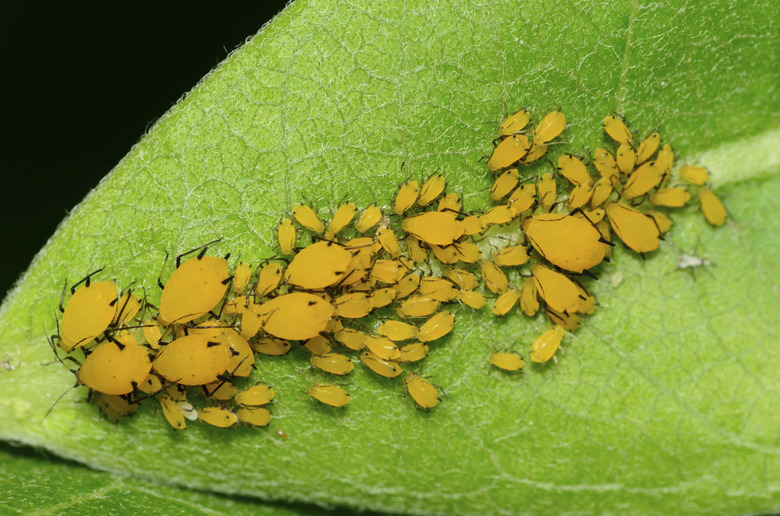How To Control Oleander Aphids
Oleander (Nerium oleander) is originally from the Mediterranean, but grows in U.S. Department of Agriculture plant hardiness zones 8 through 10. Although this shrub is relatively hardy, it may occasionally succumb to aphid infestations. Oleander aphids cause a wide range of damage, including deformed foliage. Control and eradicate the aphids to limit their effects and prevent the pests from spreading.
Warning
All parts of the oleander plant are extremely poisonous. For example, accidentally eating one leaf can kill a 150-pound adult. Keep children and pets away from this shrub, and always wear pants, a long-sleeved shirt, shoes and gloves when handling the plant. If your bare skin accidentally touches an oleander shrub, wash the area immediately with water and soap. Never burn oleander clippings because the smoke is toxic.
Aphid Infestation Signs and Symptoms
Oleander aphids (Aphis neri) are small, wingless insects that have yellow bodies and black heads. The aphids congregate on stems, leaves and around flowers. In general, aphids are most active when outdoor temperatures range between 65 and 80 degrees Fahrenheit. As they suck on the oleander plant's juices, the aphids leave behind a sticky sap known as honeydew. This honeydew may attract ants.
Natural Remedies to Control Oleander Aphids
Before trying insecticide sprays, try an all-natural remedy to eradicate aphids off of the shrubs.
- Prune affected leaves and shoots. This is one of the best ways to control an aphid infestation and keep it from spreading. Wipe down a pair of pruning shears with rubbing alcohol to sterilize them first. Discard any pruned leaves or shoots in a sealed plastic bag to enclose the removed aphids.
- Wash off oleander aphids with a strong **blast of water from a garden hose**. Most of the aphids that get knocked off by a jet of water aren't able to easily return to the oleander plant, and the water also rinses away the aphids' honeydew.
- Keep ants away from the oleander. Ants enjoy the aphids' honeydew and will actually protect and guard aphids against natural predators. Repelling ants — try wrapping the base of the oleander shrub with a sticky ant guard to keep the ants from crawling up the shrub — leaves aphids exposed to natural predators.
Tip
Spraying down the oleander with a strong stream of water is effective against aphids and often enough to solve the problem. When trying this method, spray the oleander shrub in the morning. This gives the shrub time to dry off during the day, reducing the risk of diseases.
Nontoxic Aphid Insecticide
If other methods of controlling aphids fails to eradicate this problem, mix an anti-aphid insecticide spray at home using household ingredients. This homemade solution controls aphids and other soft-bodied pests that may trouble an oleander shrub.
1. Fill an empty plastic spray bottle with 1 quart of tap water. 2. Add 2 tablespoons of liquid dish soap. 3. Stir the liquid briskly to thoroughly mix the soap with the water. 4. Spritz the soapy solution directly on aphids. 5. Repeat once every four to seven days, or until the aphids are under control.
Natural Predators Prevent Future Aphid Infestations
Many predators will control aphids. For example, ladybugs feed on aphids. You can buy ladybugs from garden stores and nurseries, then release the ladybugs to prey on and control a current aphid infestation. Eradicating aphids on a single ornamental shrub, such as an oleander, typically requires 1,500 ladybugs, followed by another 1,500 week later.
Tip
Avoid the widespread use of broad-spectrum insecticides in your yard. These products don't just kill pests, but also kill beneficial insects.

